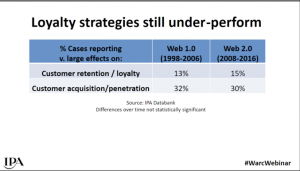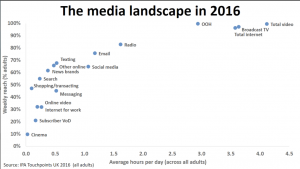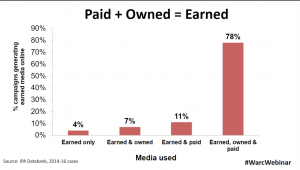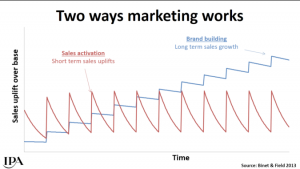A recent WARC webinar with Peter Field provided some golden nuggets of data to cut through the hype and bust some myths about marketing effectiveness in a digital age. Peter’s work is baed on mining the extensive IPA database of case studies on brand and business growth.
Myth 1: “Drive loyalty with more targeted marketing”
Peter gave a typical quote from a digital marketing guru: “Brands need to move from mass marketing to having more direct, personal relationships with their buyers.” The assumption here is that the advent of digital and social media has changed the rules of marketing, making targeting to build loyalty more feasible. However, data from the last eight years (2008-16) shows that campaigns focusing on penetration are twice as effective as those focusing on loyalty. And the numbers have barely shifted compared to the previous eight year period (2000-2008).

Myth 2: “TV advertising is dead”
In order to drive penetration you need to reach as many people as possible. And social media alone cannot deliver this reach, at least for now, as the UK data below shows (reach is on the vertical axis). Notice how TV also remains ahead in terms of hours spent watching it (horizontal axis).

The figures are different for Millenials, with social media’s reach much closer to TV, which is why brands skewed to a young target are smart to put a decent amount of their budget into digital marketing. But if you have a more mainstream audience, “traditional” media still have a key role to play.
Myth 3: “Its all about content and owned/earned media”
What’s the best way to create online word-of-mouth and buzz for your brand? Based on press headlines and marketing conferences, you would think the way to do this is to create your own amazing digital content (owned media) that gets shared online (earned media). Who needs to pay for advertising when your content ‘goes viral’? However, the IPA data shows that only 7% of the campaigns generating online buzz relied on earned and owned media alone, compared to 78% that also included paid media. The most effective campaigns tend to combine earned, owned and paid media to create a “multiplier effect”. You generally need to pay to “add fuel to the fire” of online buzz.

The re-launch of the Pot Noodle brand that we posted on here is a good example of this approach. A film called “Boxer” about a young man who dreams of success in the boxing ring was the no.1 viral video on YouTube for 2 weeks running with 184,686 shares and 1.8million views. But the campaign was ‘ignited’ with a TV campaign on prime time TV.
Myth 4: “Digital drives short terms sales. Who needs long term brand building?!”
Peter contrasted two quite different forms of marketing campaign:
- Brand building: reaches a broad target and uses emotion to create ‘fame’ and drive word-of-mouth
- Sales activation: gives information to a tight target to get them to buy now
Many brands are focusing on the latter, sales activation, as it generates an immediate measurable effect. However, the IPA data shows the most effective campaigns in terms of share and profit growth have a 60:40 split between brand building and activation efforts. This split delivers short term ‘blips’ in sales, but also enhances brand equity to deliver long term growth.

Peter made an interesting point about online brand like Google, Amazon, Uber and Airbnb that have built businesses without advertising. He suggests that they did this thanks to game-changing products during their earlier years. However, as their markets mature and competition hots up, these brands are starting to invest in conventional mass media for brand and business growth, as shown by TV campaigns for Amazon, Facebook and Airbnb
In conclusion, don’t believe the myths of modern marketing that suggest you should put all your budget and talent into digital marketing to drive ‘loyalty beyond reason’. Rather, blend the best of new and conventional media to drive penetration, combining owned, earned and paid media. And ensure you balance short terms sales driving and long-term brand building.